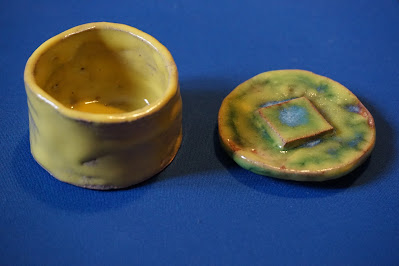These are photographs of some things I have made in the pottery workshop that is happening in Camphill Milton Keynes. A bowl, a trinket pot, a spoon and two wobbly mugs.
Pottery, one of the oldest and most widespread of the decorative arts, consisting of objects made of clay and hardened with heat. The objects made are commonly useful ones, such as vessels for holding liquids or plates or bowls from which food can be served.
Clay, the basic material of pottery, has two distinctive characteristics: it is plastic (i.e., it can be molded and will retain the shape imposed upon it); and it hardens on firing to form a brittle but otherwise virtually indestructible material that is not attacked by any of the agents that corrode metals or organic materials. Firing also protects the clay body against the effects of water. If a sun-dried clay vessel is filled with water, it will eventually collapse, but, if it is heated, chemical changes that begin to take place at about 900 °F (500 °C) preclude a return to the plastic state no matter how much water is later in contact with it. Clay is a refractory substance; it will vitrify only at temperatures of about 2,900 °F (1,600 °C). If it is mixed with a substance that will vitrify at a lower temperature (about 2,200 °F, or 1,200 °C) and the mixture is subjected to heat of this order, the clay will hold the object in shape while the other substance vitrifies. This forms a nonporous opaque body known as stoneware. When feldspar or soapstone (steatite) is added to the clay and exposed to a temperature of 2,000 to 2,650 °F (1,100 to 1,450 °C), the product becomes translucent and is known as porcelain. In this section, earthenware is used to denote all pottery substances that are not vitrified and are therefore slightly porous and coarser than vitrified materials.
 |
| A bowl |
 |
| Trinket pot |
 |
| Trinket pot with lid off |
 |
| Spoon |
 |
| Wobbly mug |
 |
| Another wobbly mug |

No comments:
Post a Comment